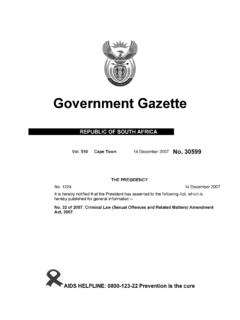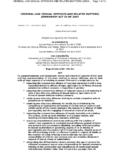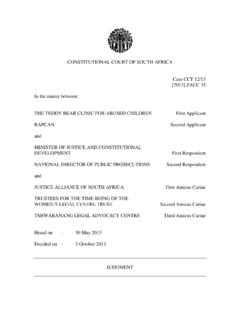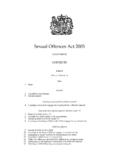Transcription of Responding to sexual assault: the way forward
1 > Vi-i > "vvi Vi /> v ViResponding to sexual assault: the way forwardDecember 2005 Attorney General s Department NSW 2006. This work is protected by copyright. You may download, display, print and reproduce this material in whole or in part, subject to acknowledgement of the source for personal, non-commercial use within your organisation. Except for any uses permitted under the Copyright Act1968 (Cth) all other rights reserved. This report reflects the law as of 20 December Design: Lorraine BealTypesetting: Oxford PublishingCriminal Law Review Division, Attorney General s Department NSWGPO Box 6 Sydney NSW : 0 7347 28662 Printed by Oxford Publishing , AustraliaFebruary2006 ContentsTTooppiiccPPaaggeessExecutive Summaryiii-viTable of Recommendations1-7 Chapter 1. Attrition in sexual offences8-17 Chapter 2. Improving the provision of services pre-trial18-31 Chapter 3. The law of consent32-51 Chapter 4. Evidence and procedure52-72 Chapter 5. Tendency and coincidence evidence73-85 Chapter 6.
2 Jury directions in sexual assault trials86-105 Chapter 7. Evidence of children106-129 Chapter 8. Disability and aged care issues130-146 Chapter 9. Specialist courts, dedicated courts, case listings147-176 Appendix 1,2,3177-183 Bibliography184-188 Schedule of cases189-190 Schedule of legislation191-192iTaskforce MembersChair of the TaskforceMr Lloyd Babb, Director Criminal Law Review Division, Attorney General s DepartmentTaskforce members:The Honourable Justice T Buddin, Supreme Court NSWMr Richard Button SC, NSW Public Defenders OfficeMr Richard Cogswell SC,Crown AdvocateDr Anne Cossins, Senior Lecturer, Faculty of Law, University of New South WalesMr Nicholas Cowdery QC AM, NSW Director of Public ProsecutionsMs Marianne Curtis, Victims Services, Attorney General s DepartmentMr Hugh Donnelly, Manager Research and Sentencing, Judicial Commission of NSWHis Honour Judge Roy Ellis, District Court NSWHis Honour Judge David Freeman, District Court NSWMr Phillip Gibson, Law Society of NSW Ms Gaby Marcus, Manager, Violence Against Women Specialist Unit, Department of Community ServicesDetective Superintendent Kim McKay, Child Protection and Sex Crimes Squad, NSW PoliceMs Julie Morgan, Legal Aid Commission of NSWMr Stephen Odgers SC, NSW Bar AssociationMagistrate Margaret Quinn PSM, Local Court NSW Ms Eija Roti, Director of Child Protection Policy, Department of Community ServicesMs Carole Ruthchild, Office for Women.
3 Premier s DepartmentMs Jo Spangaro, Child Protection and Violence Prevention Team, NSW HealthAssociate Professor Julie Stubbs, Faculty of Law, University of Sydney Ms Pia Van der Zant, Women s Legal Service NSWMs Karen Willis, Manager, NSW Rape Crisis CentreLegal Research and WritingSally Traynor, Project Officer and Policy Officer, Criminal Law Review DivisionFiona Rowbotham, Policy Officer, Criminal Law Review DivisionResearch AssistanceMarianne Carey Erin GoughRohan MascarenhasLeah BurgoyneEditingLegislation and Policy Division, Attorney General s DepartmentiiAcknowledgementsThe assistance of the following people is acknowledged: Jackie Fitzgerald, Bureau of Crime, Research and Statistics NSWI nspector Beth Cullen, Manager Strategic Support Child Protection & Sex Crimes Squad, NSW Police ServiceTamahra Manson, Senior Programs Officer Adult sexual Assault & Child Protection, NSW Police ServiceAmy Watts, sexual Assault Liaison Officer, Office of the Director of Public ProsecutionsJulie Lannen, Managing Lawyer Gosford, Office of the Director of Public ProsecutionsDebbie Scott, Senior Officer, Witness Assistance Service, Sydney West, Office of the Director of Public ProsecutionsGwen Cosier, NSW HealthLyn Mitchell, NSW HealthRochelle Braaf, Violence Against Women Specialist Unit, Department of Community ServicesJulie Blyth, Northern Sydney sexual Assault ServiceLauren Kelly, Northern Sydney sexual Assault ServiceMandy Young, Secretariat Manager, Aboriginal Child sexual Assault TaskforceJacqui Berrell, Attorney General s DepartmentiiiExecutive Summary11.
4 Evaluate alternate models for the prosecution of sexual assault offences To examine alternate methods used in other jurisdictions to prosecute sexual assault offences to see if any of the methods employed would: be capable of being utilised in or adapted to the NSW legal system; improve the way sexual assault offences are prosecuted; minimise the secondary victimisation of complainants; not impact detrimentally upon the provision of a fair trial; reduce recidivism; and be financially feasible and time and particular, to evaluate jurisdictions which employ: specialist sexual assault courts; specialist sexual assault jurisdictions; and specialist listing/case management methods (for example, dedicated trial lists and compulsory pre-trial case management). 22. Evaluate proposals for legislative and proceduralchange in sexual assault prosecutions To examine existing provisions relating to sexual assaultprosecutions to see if reform will: assist in improving the way sexual assault offences are prosecuted; provide greater recognition of the reality of sexual assault; reduce the stress and trauma sexual assault complainants face when giving evidence; and not impact detrimentally upon the provisions of a fair research and evaluate trial directions, appellate decisionsand provisions contained within the Evidence Act1995; CrimesAct1900; Criminal Procedure Act1986; and relevant actsrelating to Identify areas of possible reform in relation to the provision of services for sexual assault victimsPre-trial sexual assault services include such things as: police training and responses where reports are made; the gathering of forensic evidence by health providers; the testing of forensic evidence.
5 The provision of counselling and witness assistance (referral, availability, location and co-ordination between services); and the provision of services for particularly vulnerable complainants such as Aboriginal people, complainants withintellectual and physical disabilities and complainants from non-English-speaking backgrounds. December 2004 the NSW Attorney General, the Honourable Bob Debus, announced the establishmentof the Criminal Justice sexual Offence Taskforce (the Taskforce) to examine issues surrounding sexualassault in the community and the prosecution of suchmatters within the criminal justice system. TheTaskforce was to advise the Attorney General on waysto improve the responsiveness of the criminal justicesystem to victims of sexual assault, whilst ensuring that an accused person receives a fair A number of Government and Non-Government agencies were invited to be represented on the Taskforce including the Director of Public Prosecutions, the Legal Aid Commission of NSW, the NSW Law Society, Public Defender s Office, NSW BarAssociation, Judicial Officers from the Supreme Court,District Court and Local Court, the Judicial Commission, the Crown Advocate the Office for Women, Premier s Department, Women s Legal Services NSW, Senior Academics, the Department of Community Services, Victims Services, Attorney General s Department, the Violence Against Women Specialist Unit, NSW Police Service, NSW Health, and NSW Rape Crisis of ReferenceTerms of Reference3.
6 The Taskforce was responsible for creating its ownterms of reference based on its knowledge and experience of the issues affecting the responsivenessof the criminal justice system. The three terms of reference were to: evaluate alternate models for the prosecution of sexual assault offences ; evaluate proposals for legislative and proceduralchange in the area of sexual assault prosecutions in NSW; and identify areas of possible reform in relation to the provision of services for sexual assault The Taskforce was assisted in settling the Terms of Reference by recent inquiries conducted in other States, academic literature and judicial comment. In particular the following documents were instrumental in guiding the work of the Taskforce: NSW Adult sexual Assault Interagency Committee: A Fair Chance: Proposals for sexual Assault Law Reform in NSW,November 2004; Victorian Law Reform Commission, sexual offences : Law and Procedure Final Report 2004; The former Chief Judge at Common Law, JusticeWood QC AM, Child Witnesses Best Practices forCourt, 30 July 2004; Legislative Council Standing Committee on Law and Justice: Report on Child sexual Assault Prosecutions: Report 22, October 2002; The ALRC Review of the Uniform Evidence Act, Issues Paper, 28 and Discussion Paper 69, 4 July2005.
7 Statistics presented by the NSW Bureau of Crime, Statistics and Representation5. The representation of the Taskforce reflected the diversity of stakeholders interested in the criminaljustice response to sexual offences and, in particular, to the manner in which victims are treated by the system. Consultation on major issues was confined tothis key group of stakeholders due to the: complexity and number of issues; timeframe within which the Taskforce was required to report; and expertise of the members within this area. 6. Where there were matters beyond the expertise of the Taskforce members, relevant experts were consulted. There was no specific public consultation. However, the Taskforce was informed by responses from victims and service providers to the online surveys conducted in August 2005 by the Violence Against Women Specialist Unit, Department of Community Services. Taskforce sought to examine why victims of sexual assault may not report to police, or if a charge is laid, why a victim may decide not to continue with the prosecution.
8 The Taskforce conducted two surveys facilitated by the Violence Against Women Specialist Unit, Department of Community Services. The first survey was directed to service providers who work with victims, including counsellors, health workers, police, ODPP solicitors and witness assistance service staff and court staff. 8. The second survey was aimed at victims who had been in contact with health services and the criminal justice system in the last 10 years and sought to understand some of the obstacles victims face in the criminal justice process and factors that may encourage victims to continue and give evidence at court. surveys were made available online from 14 July to 12 August 2005. Over 105 victims and 191 service providers responded to the surveys, providing a valuable source of contemporary information to the Taskforce about the concerns and problems encountered in the criminal justice system.
9 The results of the surveys were analysed by the Violence Against Women, Specialist Unit, Department of Community Services and forwarded to the Taskforce to be taken into account when making recommendations. ivManagement of the Taskforce10. A Project Plan was adopted by the Taskforce at its meeting in April 2005 outlining the issues to be discussed over the course of the year. Discussion at meetings was facilitated by the production of a series of Discussion Papers developed and writtenby the Criminal Law Review Division, outlining the relevant law and issues and posing draft recommendations to be considered. 11. The Discussion Papers canvassed the current law in NSW and other jurisdictions with respect to sexual assault offences and what amendments may be desirable and worthy of implementation. In particular, the Taskforce examined: the number of reported sexual assault cases that are prosecuted and the outcomes of thosematters, including the number of victims whosecases may not proceed through the criminal justice system and why so many cases do not proceed; how to improve the provision of information andservices to people who have been sexuallyassaulted; the law in relation to consent; the test for the admissibility of evidence of sexual experience and reputation; the efficacy and practice regarding committal proceedings involving adult sexual assaultcomplainants; pre-trial disclosure and case management; non-publication orders in sexual assault trials; directions to juries in sexual assault trials; the test for the admissibility of tendency and coincidence evidence; whether there should be a presumption that multiple complainants should be dealt with together in the same trial against the accused.
10 The evidence of children and whether existing mechanisms and court practices provided adequate safeguards against children being re-traumatised by the court process; practices and procedures regarding the safety, protection and rights afforded to people with intellectual disabilities and other cognitive impairment and people living in aged care residential facilities in light of their vulnerability to sexual assault; whether there should be a specialist court, or adedicated and specialised approach to prosecuting and hearing sexual offence cases; how to improve the management of sexual offences cases through the courts and reduce delays; and whether any alternative models or approaches should be included in any recommended specialised Members had the opportunity to advance their views at the meetings and to provide written submissions. Members were encouraged to debate the issues and explore, in detail, the advantages and disadvantages of proposed In order to cover all the material and obtain further information from relevant agencies involved in the Taskforce, three working groups were established to examine the following matters: rates of attrition in sexual assault matters; evidence of children and vulnerable witnesses; and improved interagency The assistance of government agencies and their co-operation in sharing data and knowledge is greatly appreciated.









